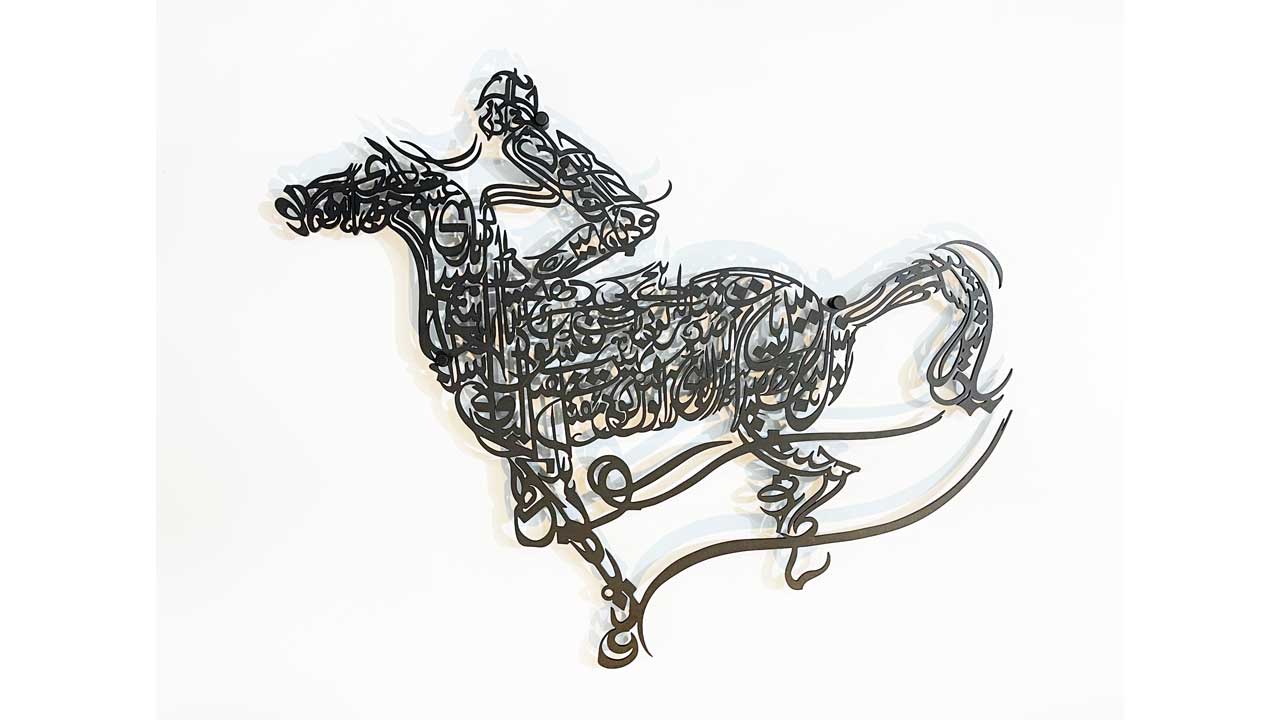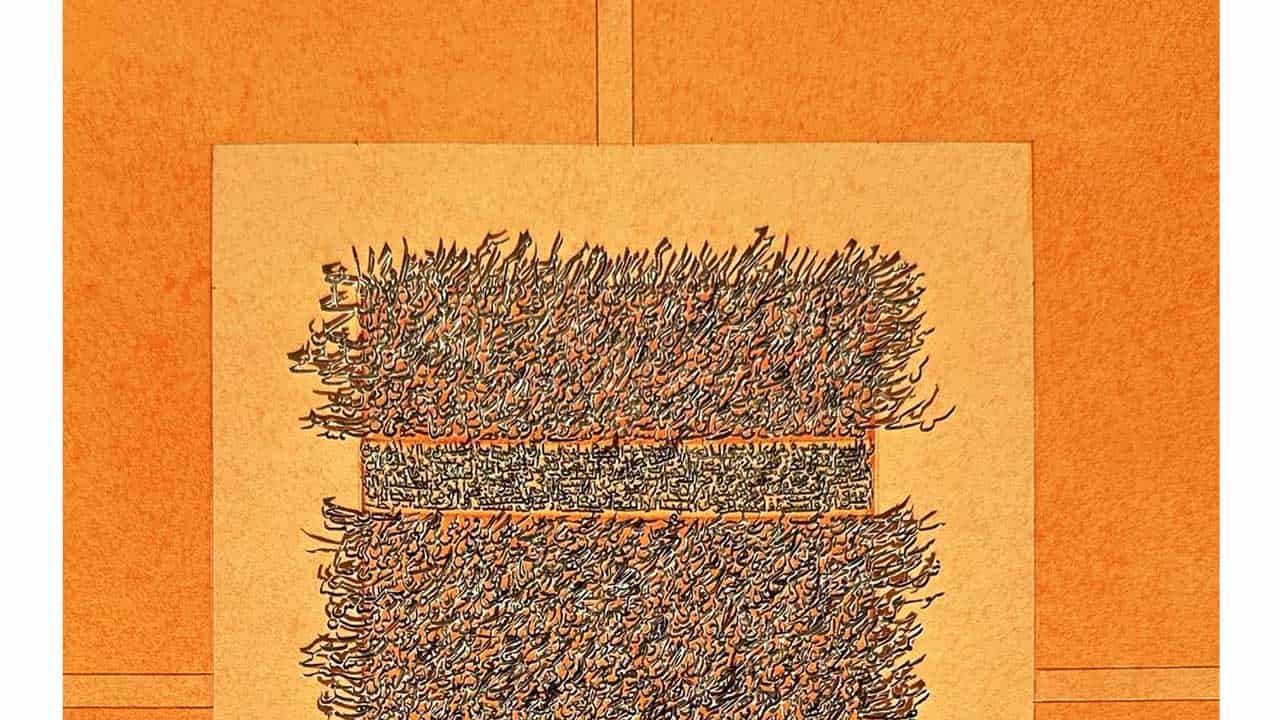The recent 2025 floods in Pakistan echo a devastatingly familiar script from 2022. A recurring nightmare has once again befallen our nation: villages submerged, millions displaced, and an overwhelmed relief system1 . More than 4.2 million people were affected and 4,100 villages inundated this year2. Yet statistics alone cannot capture the personal loss borne by each individual. Such expression often requires other media— literature, film, or, in this case, art. In the exhibition Sailaab, art is used in a way that makes the disaster feel real, an expression that numbers alone lack.
Curated by Amra Ali and exhibited at AAN Art Space & Museum in Karachi, Sailaab gathers artists whose works engage with how the water flows in a transformative and destructive way. The artists’ way of conveying their message has a wide spectrum of memory and critique: Arif Mahmood’s 2010 flood documentation and Saad Aslam Ali’s resurrected family photographs, to conceptual journeys of Rasheed Araeen’s Chakras, and the cartographic investigation of Namra Khalid. Each artist has a different relationship with the floods, from loss and displacement to the relentless reclamation of land by water.
Within this powerful ensemble, Sohail Zuberi’s installation offers one of the most visceral and immediate experiences. Zuberi’s contribution is not just a display of the floods but rather a reliving of his own experience. His work is an intimate reckoning with the night Karachi itself drowned in July 2022. As Torrential monsoon rains, 190% above average that year, with Sindh receiving a catastrophic 460% of its usual rainfall3, inundated the city, Zuberi’s home, along with countless others, was flooded. He spent four long days without electricity, “surrounded by water, silence, and dread.” Zuberi’s installations are the narration of that calamity.

The artist’s work translates this experience into a multi-sensory environment. Silent Apertures consists of nine backlit images housed within PVC pipes, with sinkers (bhaari) fitted inside the PVC pipes for viewers to peek inside and view the art. Each glimpse is a wound, a whisper the flood left behind. The streets turned into rivers due to the city’s failed drainage system, which was exacerbated by a lack of infrastructure and poor planning. This can cause the water level or rainwater to rise in the surrounding areas, as it has no way to flow away4. The backlit images glow, like distant, submerged memories, forcing the viewers to peer into these portals of personal history.

Silent Apertures performs a powerful social function. The artist designed the installation in such a way that it requires the viewers to stoop and peer through the apertures, concentrating through the narrow pipes. This deliberate act forces engagement, as many viewers may have been fortunate enough to stay dry throughout the actual floods. This installation burdens them to make an effort and see what the people on the other side experienced. Zuberi denies the audience a comfortable viewing experience, to witness the trauma, one must make an effort, bending to meet the artwork.
Zuberi’s work moves beyond testimony, into critique. The 2022 floods were not just a natural disaster— they were a product of blocked floodplains and poor river flow management5. The installation materializes this systemic failure. As you glance through these pipes, the images are reliquaries for what was lost when the city’s infrastructure collapsed.

The companion piece, Threshold, is a 16-second looped 4k video, capturing the moment of the system failing, water surges through the entrance— the arist remains stationary, in this moment he is powerless. “Inside and outside collapse into one”6, this single, relentless moment perfectly encapsulates the universal vulnerability felt across Pakistan in both 2022 and 2025. The helpless moment when the border between safety and danger collapses, home and havoc mix together, and there is nothing more you can do than just wait it out.

While articles rightly call for “flood accountability”7 and warn of threats to “national food security”8, Zuberi’s work does what these reports lack: his art revives this crisis in a palpable way, showing exactly how “Pakistan’s summer oases turned into deadly flood zones”9. It translates a macro tragedy of a nation submerged, a crisis that prompted a global aid response for over 33 million affected people10 into a micro reality of ruined belongings, a silent dread.
Sohail Zuberi’s installations in Sailaab are more than an exhibit, they are an imperative act of documentation and preservation in a country where floodwater is reported to be “rising in some districts” long after the rains stop11, creating a persistent sanitary and health crisis. Zuberi preserves the flood of emotions— containing this flood through looped videos and backlit images placed in the gallery as a solemn yet terrifying reminder. His work ensures that we feel the weight of the flood on an individual level rather than just reading about it, one narrative at a time.
The 2022 flood was dubbed as a “1-in-100-year event”12, yet just three years later in 2025 and 12 years earlier in 2010, we face(d) rain of similar magnitude. This probability suggests that the climate models used for this might be obsolete. What was once a 1% chance of happening every year is now much higher and must be recalculated. While possible by chance, it strongly indicates that climate change has fundamentally altered the underlying probabilities. If we were to assume, for example, the new probability is around 10%, then the chance for all of this to happen again in the next four years is a frightening 40%. This math makes preparation not a choice, but an urgent necessity.
The group exhibition titled ‘Sailaab’, curated by Amra Ali, was held at AAN Art Space & Museum from 28th August 2025 to 18th October 2025. The showcasing artists included Arif Mahmood, Malika Abbas, Namra Khalid, Rasheed Araeen, Saad Aslam Ali, and Sohail Zuberi.
Title Image: Silent Apertures, PVC pipe, found bhaari (sinkers), backlit images, LED, lights, electrical wire, Nine pieces in various size, 2025.
Image courtesy @ AAN Art Space & Museum
Bibliography
Ahmed, Amin. Floodwaters rising in some districts: UN. 26 September 2022. <https://www.dawn.com/news/1712040/floodwaters-rising-in-some-districts-un>.
More flood aid pours in as world lends a helping hand. 31 August 2022. <https://www.dawn.com/news/1707664/more-flood-aid-pours-in-as-world-lends-a-helping-hand>.
Dewan, Angela. Experts slam ‘pittance’ in aid to Pakistan as they find climate crisis played a role in floods. 16 September 2022. <https://edition.cnn.com/2022/09/15/asia/pakistan-climate-floods-attribution-intl>.
Flood accountability. 5 September 2025. <https://www.dawn.com/news/1939809/flood-accountability>.
Kiani, Khaleeq. Billions lost: Floods spark agri-emergency call. 5 September 2025. <https://www.dawn.com/news/1939745/fbillions-lost-floods-spark-agri-emergency-call>.
Noack, Rick. Climate change turns Pakistan’s summer oases into deadly flood zones. 5 September 2025. <https://www.washingtonpost.com/weather/2025/08/30/pakistan-floods-climate-change-gilgit/>.
Over 4.2m people, 4100 villages affected in Punjab amid record floods, says PDMA. 6 September 2025. <https://www.dawn.com/news/1940178/over-42m-people-4100-villages-affected-in-punjab-amid-record-floods-says-pdma>.
Raz, Benazir. 2022 floods, a living nightmare. 17 September 2022. <https://www.dawn.com/news/1710561/2022-floods-a-living-nightmare>.
- (Flood accountability)
- (Over 4.2m people, 4100 villages affected in Punjab amid record floods, says PDMA)
- (Raz)
- ibid
- ibid
- Quoted from the exhibition catalog preview
- (Flood accountability)
- (Kiani)
- (Noack)
- (Ahmed, More flood aid pours in as world lends a helping hand)
- (Ahmed, Floodwaters rising in some districts: UN)
- (Dewan)
Ahmed Mustafa
Ahmed Mustafa is an A Level student at Nixor College with a strong academic interest in Mathematics and a deep passion for Art and Design. Having studied Arts and Design during his O Levels at Beacon House School, he has created numerous installations for school exhibitions, often using art as a medium to comment on climate change, sustainability, and environmental awareness. Combining his analytical mindset with creative expression, Ahmed aims to explore and propose innovative solutions to real-world problems through the intersection of art and science. Currently Ahmed is enrolled in A2 at Nixor College, Karachi, focusing on Maths, Economics and Physics.



There are no comments